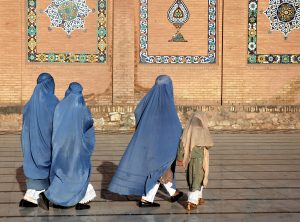The status of women’s rights has steadily and predictably eroded under Taliban rule, in this second experiment by the terrorist group to remold Afghanistan to their puritanical vision of a society where women have no rights or freedoms. Girls have been banned from attending school past grade six since the group regained power in 2021, and women have been banned from higher education since December 2022. The country remains in an economic freefall, suicides among women and girls are occurring at alarming rates, and Afghans continue to try flee the country in great numbers, despite the considerable risks and challenges in doing so.
The Taliban’s gender apartheid state, its human rights abuses, and its failure to form an inclusive government have meant that no country in the world has recognized the Taliban as the legitimate government of Afghanistan. Afghanistan’s seat at the United Nations is still held by a representative from the previous regime, as are many of its embassies abroad. Near universal condemnation, the loss of investment and trade partners besides its standing in the international community, and consistently negative press have not deterred the Taliban.
Understandably, the situation requires a policy shift. But warming up to the Taliban is not the right move. On the contrary, it sends a dangerous message that their behavior is working and grants them the respect of engagement, which they have not earned.
In November, Rangina Hamidi, a former Afghan education minister now residing in the United States, called for increased engagement with the Taliban “while adapting to the restrictions on education, in particular by using madrassas as an alternative route to education and learning.”
Madrassas are religious schools that typically provide mainly religious instruction with a rudimentary education in a limited number of other subjects, like literacy and math. They are no substitute for full, equitable access to public education at every level for girls. In fact, madrassa-based education for boys and girls alike is cause for concern. Their record on learning outcomes is poor, and their potential to be a vehicle for mass indoctrination into the ideology of religious terrorism is high. As one Afghan teachers wrote, “Crafted in accordance with the Taliban’s uniquely strict interpretation of Islamic law, the regime’s draft madrassa curricula for men and women alike aim not to foster education, but rather to give rise to a new generation of jihadists.”
While Afghan women and their allies are rightfully skeptical about this proposed compromise, the Taliban were enthusiastic. In December, they announced that girls of all ages were now permitted to enroll in madrassas.
If this is indicative of the kind of measures that Afghan women and girls can expect as a result of engaging with the Taliban, then engagement is absolutely the wrong direction.
It’s worth mentioning that there is already both political and economic engagement occurring with the Taliban. It has had no impact whatsoever on moderating the Taliban. The group has proven itself indifferent to global opinion and immune to the displeasure of nearly the entire global community, from Muslim-majority countries to the U.N. to the EU, Canada, and U.S., even to their erstwhile friends in Moscow and Beijing. Policy decisions in Afghanistan are dictated by the reclusive supreme leader in Kandahar, Hibatullah Akhundzada, whose reference point appears to be solely his own personal preferences and views about how Afghan society ought to look. He is ready to enforce those views at any cost, including Afghanistan’s isolation from the world community and its continued economic collapse, with the result of plunging millions of Afghans into deadly poverty.
Observers urging engagement, including in my home country of Canada, have advocated for the re-establishment of a diplomatic presence in Kabul without articulating how such a move could lead to improving the women’s rights crisis. Instead, policymakers should take their direction from those on the ground who are directly impacted by the Taliban’s discriminatory policies.
Notwithstanding prominent and controversial exceptions such as Mahbouba Seraj, women living in Afghanistan have urged caution about closer engagement. In one of its quarterly surveys of Afghan women – representing 22 of the country’s 34 provinces and from all walks of life – U.N. Women reported that “Almost all women consulted thought that U.N. recognition of the Taliban should not happen under any circumstances or that it should only occur under specific conditions contingent on improving women’s rights.” Further, women living in Afghanistan made clear their priority for the international community’s efforts is improving their rights, over and above the humanitarian crisis or the economic situation of the country.
Afghan women have vigorously demanded the full restoration of their right to education, without compromises carried on their backs. Those of us who have the good fortune to live in societies where girls and women can attend school should demand that our political leaders heed their call. The international community urgently needs a strategy to restore the right to education for all in Afghanistan. It should be one that simultaneously restores the legitimacy of the U.N. and its member states, especially those with feminist foreign policies, by walking their talk, conveying with conviction that a watered down right to education, like crude religious education in lieu of a full academic education, is no right at all.

































